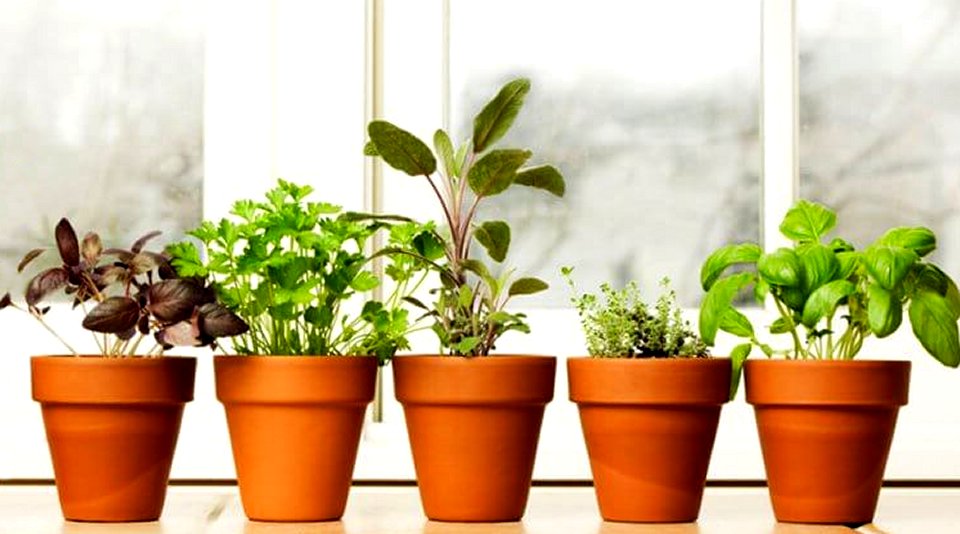Indoor Herb Garden
One of the best ways to gently transition into the alternative lifestyle is to start growing some organic herbs at home. Doing this teaches you basic gardening skills without requiring a huge time commitment on your part. In this article I’m going to be highlighting five herbs you can easily grow at home and explaining exactly how to grow them.
5 Herbs You Can Grow At Home
1) Basil
Basil is a tasty herb that has anti-bacterial and anti-inflammatory properties. To grow it indoors, you will need:
– A pot with drainage holes at the bottom and a dish to catch the water
– Basil seeds
– Coarse soil that drains easily
Once you have these three things, simply follow the instructions below to grow your Basil:
1. Place the pot in a sunny south facing window.
2. Fill the pot with 3/4 of soil.
3. Add enough water to mildly dampen the soil.
4. Sow the seeds a couple of inches apart.
5. Cover the seeds with 1/4 inch of soil.
6. Moisten the soil regularly with a plant mister (once every day or every couple of days).
7. Once Basil leaves start to grow, cut them off and use them as you please.
2) Chives
Chives are an extremely versatile herb that can be eaten with almost any food. To grow chives indoors, you will need:
– A pot with drainage holes at the bottom and a dish to catch the water
– Chive seeds
– Coarse soil that drains easily
Once you have these three things, simply follow the instructions below to grow your chives:
1. Place the pot in a sunny south facing window.
2. Fill the pot with 3/4 of soil.
3. Add enough water to mildly dampen the soil.
4. Sow the seeds a couple of inches apart.
5. Cover the seeds with 1/4 inch of soil.
6. Moisten the soil regularly with a plant mister (once every day or every couple of days).
7. Once the chives start to grow, simply trim them and enjoy.
3) Oregano
Oregano has anti-viral and soothing properties and is a great remedy for stomach ache and sore muscles. Unlike Basil and chives which both grow well from seeds, oregano seeds are very unpredictable and it’s much better to grow oregano from a young plant. To grow oregano indoors, you will need:
– A pot with drainage holes at the bottom and a dish to catch the water
– A young oregano plant
– Garden lime
– High quality potting soil
– Perlite
Once you have these things, simply follow the instructions below to grow your oregano plant:
1. Place the pot in a window that provides bright, indirect sunlight.
2. Pot the oregano plant using the potting soil, a handful of perlite and a pinch of garden lime.
3. Water the plant thoroughly and firm up the soil to remove air bubbles.
4. Continue watering the plant once or twice per week, depending on how moist the soil is.
5. Once the oregano plant starts to bloom, remove the leaves and use them in your cooking.
4) Peppermint
Peppermint tastes great with soft, dark meats such as duck and lamb. To grow peppermint indoors, you will need:
– A pot with drainage holes at the bottom and a dish to catch the water
– Peppermint seeds
– High quality potting soil
Once you have these three things, simply follow the instructions below to grow your peppermint:
1. Place the pot in a sunny south facing window.
2. Fill the pot with 3/4 of potting soil.
3. Sow the seeds about an inch apart.
4. Cover the seeds with 1/8 inch of soil.
5. Moisten the soil sparingly with a plant mister (peppermint thrives in relatively dry soil so check the soil for dryness every a couple of times per week and water it accordingly).
6. Once peppermint leaves start to grow, cut them off and use them as you please.
5) Thyme
Thyme is packed full of antioxidants that support your heart, keep your blood healthy, protect against chronic disease and much more. To grow thyme indoors, you will need:
– A pot with drainage holes at the bottom and a dish to catch the water
– Thyme seeds
– High quality potting soil
Once you have these three things, simply follow the instructions below to grow your thyme:
1. Place the pot in a sunny south facing window.
2. Fill the pot with 3/4 of potting soil.
3. Sprinkle the seeds on top of the soil.
4. Cover the seeds with 1/8 inch of soil.
5. Water the soil sparingly once it has dried (thyme grows best in relatively dry soil so check the soil for dryness a couple of times per week and water it accordingly.).
6. Once thyme leaves start to grow, chop them off and enjoy them with your food.
I hope this article helps you get started growing your very first herbs. Once you’ve mastered growing the five listed in this article, you can expand your gardening skills, learn to grow all the herbs you need and never have to buy any herbs again.
